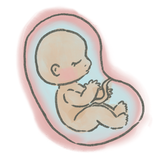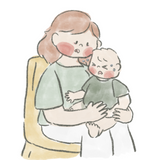Baby Sleep Cycles
Unlike adults, babies sleep and wake in short bouts, at seemingly random times throughout day and night. They are also light sleepers, and are easily aroused from sleep.
This is in part because babies have yet to develop strong circadian rhythms, which means they've yet to learn the difference between day and night. They also have tiny tummies and therefore need to wake frequently to feed.
But there is another fundamental reason - a baby's sleep cycle is much shorter compared to that of an adult's, and they spend much more time in light sleep, causing the baby to wake more frequently and easily. Not what sleep deprived parents would want to hear, however, there are important health and development benefits to the way baby sleep cycles works. And being aware of your baby's normal sleep cycles can help minimise the stress and anxiety you may be feeling, leading to a happier baby and happier you.
Baby Sleep Cycles
Sleep may seem like a steady state that carries us through the night, but our sleep actually consists of sleep cycles which repeat many times throughout the night. Each sleep cycle, which comprises of 5 different stages of sleep, is separated by a brief awakening (Most often, by morning we can't remember having woken).
There are two types of sleep; Non-REM sleep (makes up 4 stages of a sleep cycle) and REM (rapid eye movement) sleep. During a sleep cycle, babies, like adults, move through various stages of these Non-REM and REM sleep. A baby enters stage 1 at the beginning of the sleep cycle, then moves into stage 2, then 3, then 4, then back to 3, then 2, then to REM. These cycles may occur several times during sleep.
Non-REM Sleep
Stage 1 Drowsiness:
This is where your baby slips from being drowsy into light sleep. During this stage your baby's eyes becomes droopy, mouth may open and close, breathing becomes more regular. She becomes less aware of her surroundings, but she is easily awakened by movement or noise.
Stage 2 Light Sleep:
Your baby is now in light sleep. Her heart rate slows down and temperature decreases. She may twitch, smile, make small grunting noises, jerk or move her limbs. While she may become less and less aware of her surroundings, she can still easily startle if you move her or make a sudden loud noise. From here, your baby will progress into deep sleep stage.
Stage 3 Deep Sleep:
This stage is also known as quiet sleep. During this stage your baby is quiet and moves very little. Her breathing is slower and more rhythmic, muscles are relaxed, arms and legs are limp. It becomes a little harder to arouse your baby from this state, because her body becomes less responsive to outside stimuli. From here, your baby may or may not progress into very deep sleep stage.
Stage 4 Very Deep Sleep:
This stage of sleep is very similar to previous deep sleep stage, only your baby is in much deeper sleep.
REM (rapid eye movement) Sleep
REM sleep is where dreams occurs, and is often referred to as "active sleep" because it involves increased brain activity. During this stage of sleep, your baby will exhibit fluttering eyelids, relatively rapid irregular breathing, occasional body movements and vocalisations (grunts or brief cries).
Like adults in REM, babies engaged in this light form of sleep awaken more easily. Parents observing their baby may mistakenly think their baby is about to wake and may pick them up. But despite her movements your baby is truly asleep and you should not wake her up from this important sleep phase.
Awakenings - No One Truly Sleeps Through The Night
Each sleep cycle is followed by a brief awakening. Waking up between sleep cycles is very normal (and essential to our survival) for both babies and adults.
As adults, we may briefly wake between our sleep cycles, and we may adjust our pillow, straighten our blanket, or roll over, but we generally fade right back into sleep without any memory of it. During this brief wake period, if we were to realise that the bed we went to sleep on at the start of the night was missing, we would be startled and wake up immediately.
It is also the same with babies - they often wake up between sleep cycles and cannot return to sleep because their sleep environment has changed (if they are not hungry, too hot, too cold or unwell) since they fell asleep. For example, a baby may have fallen asleep in her mother's arms and awakens between sleep cycles to find herself in a crib with her mother missing. The baby might then get upset and cry out for her mother to return. This is very normal behaviour; this does not mean your baby has a sleep problem.
The Difference Between Adult and Baby Sleep Cycles
Even though babies move through sleep cycles as adults do, their sleep cycles are much shorter and numerous. They also spend much more time in REM/active sleep than adults do. Therefore it is normal for babies to awaken from their sleep more frequently.
Babies Have Shorter Sleep Cycles
Following is an approximate sleep cycle duration form newborn to adulthood:
- Newborns 20 to 40 minutes
- Babies 30 to 60 minutes
- Children 40 to 90 minutes
- Adults 90-100 minutes
Babies Spend More Time in REM/Active Sleep
Although babies spend on average around 16 hours each day sleeping, at least half of this is in REM/active sleep. Over a 24-hour day:
- newborns spend as much as 75% of their sleep in active sleep,
- growing babies and young children spend around 50% of their sleep in active sleep,
- compared to only 20% for adults.
The Benefits of Baby Sleep Cycles
Babies' short sleep cycles and active sleep may sound like a hard deal for parents, but there are important considerations and benefits to this:
- It is normal for adults and babies alike to experience frequent arousals during sleep, and most of these arousals do not result in waking up all the way. A baby who seems to be waking up may, if left alone, go back to sleep very rapidly.
- In survival perspective, babies benefit from being light sleepers. They spend most of their time in light seep, this is mostly so that they can awaken easily in uncomfortable or threatening situations, e.g. hunger, wetness, discomfort, or pain.
- A baby's sleep pattern facilitates brain growth and physical development. Babies grow at an astronomical rate during the first two years of life, and their sleep patterns reflect biological needs that differ vastly from those of adults.
All stages of sleep are important for your baby's growth and development. As she matures, so does her sleep cycles. Understanding that a baby naturally and necessarily follows a particular sleep cycle is crucial to understanding your baby's growing needs. Being aware of her normal sleep cycles can help minimise the stress and anxiety you may be feeling, leading to a happier baby and happier you.


 Australian Dollar (AUD)
Australian Dollar (AUD)
 Hong Kong Dollar (HKD)
Hong Kong Dollar (HKD)
 Japanese Yen (JPY)
Japanese Yen (JPY)
 Singapore Dollar (SGD)
Singapore Dollar (SGD)
 South Korean Won (KRW)
South Korean Won (KRW)
 United Arab Emirates Dirham (AED)
United Arab Emirates Dirham (AED)
 Canadian Dollar (CAD)
Canadian Dollar (CAD)
 British Pound (GBP)
British Pound (GBP)
 Euro (EUR)
Euro (EUR)
 Swiss Franc (CHF)
Swiss Franc (CHF)
 Swedish krona (SEK)
Swedish krona (SEK)








